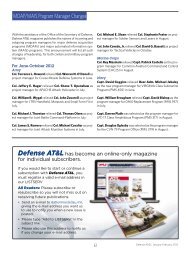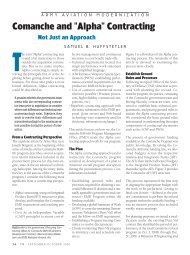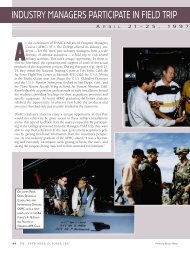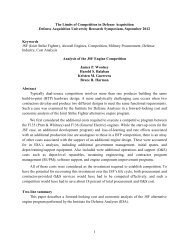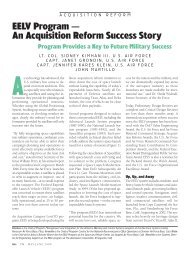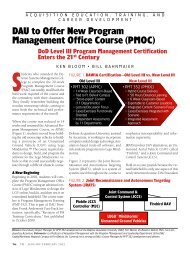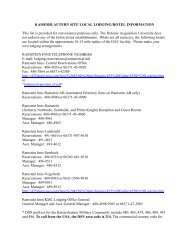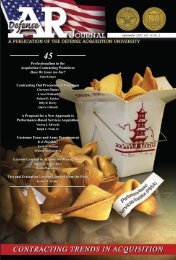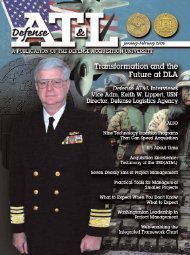Defense ARJ - Defense Acquisition University
Defense ARJ - Defense Acquisition University
Defense ARJ - Defense Acquisition University
Create successful ePaper yourself
Turn your PDF publications into a flip-book with our unique Google optimized e-Paper software.
<strong>Defense</strong> <strong>Acquisition</strong> Review Journal<br />
tAble 2. prograM staBility<br />
Type of Instability Question/Response<br />
Funding uncertainty 6 of 12 disagreed strongly that there<br />
was uncertainty about the future of<br />
project funding.<br />
Project slow-down 8 of 13 projects were not stopped and<br />
restarted or slowed down.<br />
Funding cut-backs 5 of 13 escaped changes or<br />
compromises forced by cut-backs in<br />
project resources.<br />
Turn-over in Army user representatives All projects experienced changes<br />
in key TRADOC personnel during<br />
development. This occurred only once<br />
or twice for 7<br />
of 13.<br />
Change in systems requirements 4 of 13 had no changes in systems<br />
requirements during development.<br />
Change in system requirements 4 projects experienced systems<br />
requirement changes* in the middle<br />
of development; in 3 these changes<br />
occurred late in development<br />
*Responses selected as many periods as applicable from the stages of planning;<br />
early, mid- and late development; and transition.<br />
“instabilities” impacted program outcomes. Table 2 contains the aggregate results<br />
from questions that were used in the research, categorized by type of instability.<br />
A somewhat surprising result is that there was widespread occurrence of all these<br />
forms of instability in the pre-DESERT STORM development programs studied<br />
here. Looking back at the successful performance of new Army systems in DESERT<br />
STORM, one might think that their development benefited from strong and stable<br />
environments, but the evidence shows that the external environment then was not<br />
unlike what one might find today.<br />
financial uncertainty anD ProJect cutBacks<br />
Where potential or actual funding changes were encountered (“financial uncertainty”),<br />
it appears to have had significant consequences. When one looks at the<br />
projects that are reported to have been slowed (i.e., experienced a lengthening of the<br />
planned development phase), all five also experienced problems due to financial cutbacks.<br />
By comparison, only three of eight that were not slowed experienced problems<br />
due to cutbacks (Table 3). While program slow-down may be caused by a variety of<br />
factors besides or in addition to budget cuts, once slowed, programs seem to have<br />
continuing financial problems. Given that cutbacks are often the first signal that a<br />
118



